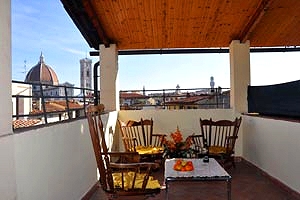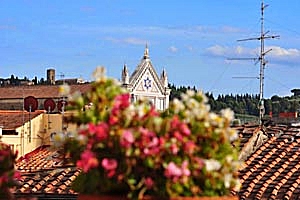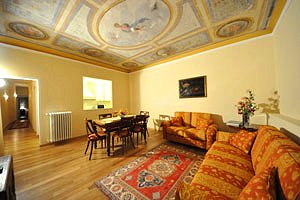The Uffizi Gallery in Florence

Florence - Uffizi Gallery
The building that is now seat of the Gallery was built in the mid-sixteenth century by the architect Giorgio Vasari (1511-1574) in a period when Cosimo I de` Medici, Grand Duke of Tuscany, was bureaucratically consolidating this recently acquired position. The building was meant in fact to house the offices of the magistrates (Uffici=offices). From the beginning however, the Medici set aside some of the rooms on the third floor to house the finest works from their collection. Two centuries later, thanks to the generosity of the last heir of the family, Anna Maria Luisa, their collection became permanent, public property. The museum now comprises the rooms on the third floor of the building, that display in chronological order paintings ranging from the 13th to the 18th centuries. The most precious and famous group of paintings of the Uffizi are however represented by the works of the Italian Renaissance artists, although several sections of the museum are devoted to the works of foreign artists (German, Flemish, Dutch and French). On the ground floor it is still possible to admire the remains of the ancient Romanesque church of San Piero Scheraggio, which was partially destroyed by Vasari to build the Uffizi. The second floor houses the Prints and Drawings Department, which comprises one of the most important collections in the world that was started by a Medici, the Cardinal Leopoldo, during the 17th century

The Spring - Botticelli
If we follow the natural layout of the rooms, we enter the large rooms that display the great altarpieces of Cimabue, Giotto, Duccio di Buonmsegna, the first remarkable examples of western painting, followed by the remarkable works of 14th century Siennese artists, such as Simone Martini and the brothers Piero and Ambrogio Lorenzetti and the pupils of Giotto. The following rooms display some fine examples of the International Gothic style: the Adoration of the Magi by Gentile da Fabriano and another one by Lorenzo Monaco, before actually reaching the most important rooms of the museum that are dedicated to the early Renaissance. These rooms exhibit works by Masaccio, Paolo Uccello, Domenico Veneziano, Piero della Francesca, Beato Angelico, followed by the elegant Madonnas of Filippo Lippi, by the precious panels of the brothers Piero and Antonio del Pollaiolo to end with the mythological allegories and religious paintings of Sandro Botticelli. Of this artist, the museum preserves perhaps the finest collection of works, comprising the Birth of Venus, the Primavera, the Magnificat and Pomegranate Madonna. It is then the turn of Perugino, Signorelh, Piero di Cosimo and Leonardo da Vinci; the latter is represented both with the painting the Baptism of Chrut painted together with Verrocchio, the large Adoration of the Magi and his early work the Annunciation

Tondo Doni - Michelangelo
The following rooms (from n. 18 to n. 23) are the oldest of the museum; it is well worth stopping to admire the Tribuna that originally contained the most precious works and objects. Today it displays also a series of portraits of the Medici family by Agnolo Bronzino, in addition to the oldest sculpture piece of the museum, the Medici Venus. The following rooms, originally used as armouries, offer again more paintings by Renaissance artists, both Italian with works by Bellini, Giorgione, Mantegna and Correggio and foreign artists `with paintings by Durer, Cranach, Memling. Continuing along the rooms on the western side of the Gallery, it is possible to admire more 16th century masterpieces, starting from the "Tondo Doni" by Michelangelo, the Madonna of the goldfinch by Raphael and the Venus of Urbino and Flora by Titian. Even the section dedicated to Mannerism is lavish and comprises works by Pontormo, Rosso Fiorentino, Bronzino down to Parmigianino (Madonna with the Long neck) and famous Venetian artists such as Sebastiano del Piombo, Veronese, Tintoretto, and Lombard ones like Savoldo and Moroni. Until not so long ago the visit to the gallery ended with some 17th century works by famous Italian (Caravaggio, Carracci) and Dutch (Rembrandt) artists. The museum has recently restored the last rooms of this section after the explosion of 1993, also in view of the enlargement of the lower floors of the building that were occupied by the State Archive until not so long ago. The project for the "New Uffizi gallery", which is already underway, will significantly alter the original layout of the museum, doubling the exhibition rooms. Thanks to this new arrangement it will be possible to distribute more evenly works that are now concentrated in a few rooms, exhibit paintings that are now stored in the gallery`s warehouses or include whole collections that had to be displayed elsewhere, like the Contini Bonacossi collection, due to lack of space. It is too early to foresee the exact layout of the new gallery, although it is certain that the collections will be arranged m chronological order and by schools. The eastern section of the ground floor will be instead used to welcome visitors and to house the bookshop, with new rooms designed to offer a more comfortable and tidier approach to the large number of tourist that visit the Uffizi all the year round. The visit to the Gallery could ideally end with another section: that is the famous Vasarl Corridor, built bjr Vasari in 1565. The Corridor joins the Uffizi to Palazzo Vecchio, crosses the river Arno above Ponte Vecchio and is connected with Palazzo Pitti and the Boboli Gardens. Recently restored after the explosion of the bomb, the corridor now displays over seven hundred works comprising mainly the important group of Self-portraits (from Andrea del Sarto to Marc Chagall). At present the corri dor can be visited only by groups and by reserving the visit ahead. In 1998 the Gallery has also acquired the Contini Bonacossi collection, with temporary entrance from Via Lambertesca. The collection had been formerly displayed in the Palazzina della Meridiana of Palazzo Pitti due to lack of space. The collection comprises thirty-five paintings, twelve sculptures, eleven large coats of arms by Della Robbia, in addition to a remarkable group of ancient furniture pieces and majolicas, which were originally part of perhaps the most prestigious collection ever gathered, belonging to Alessandro Contini Bonacossi. The most important pieces are now property of the State, after long and complex hereditary negotiations with the heirs. Its acquisition significantly enriches the patrimony of the Uffizi. Among its pieces we find works attributed to Cimabue and Duccio, m addition to large wooden panels by Sassetta and Giovanni del Biondo, a fresco by Andrea del Castagno and a superb group of paintings of Venetian artists (Veronese, Giambellino, Tintoretto, Cima da Conegliano). One of the most precious pieces is the San Lorenzo, an early -work by Gian Lorenzo Bernini ..... from `Museums and Galleries of Florence and surroundings` ( Apt - Florence )
Uffizi Gallery ... read more ..
Uffizi Gallery
Our most requested apartments in the Florence historical centre:
 Holiday apartments in pretty villa on the southern outskirts of Florence, in the vicinity of Piazzale Michelangelo. Accommodation for groups of 4/6/8/10/12 people. Air conditioning, Internet connection. Just a few minutes from Florence historical centre.
More details
Holiday apartments in pretty villa on the southern outskirts of Florence, in the vicinity of Piazzale Michelangelo. Accommodation for groups of 4/6/8/10/12 people. Air conditioning, Internet connection. Just a few minutes from Florence historical centre.
More details
 Beautiful apartment sleeping 6+2 in Florence historic centre, at a stone`s throw from Santa Maria Novella railway station. Air conditioning, Internet connection and panoramic balcony with view over the Duomo and the Medici Chapels.
More details
Beautiful apartment sleeping 6+2 in Florence historic centre, at a stone`s throw from Santa Maria Novella railway station. Air conditioning, Internet connection and panoramic balcony with view over the Duomo and the Medici Chapels.
More details
 Apartment sleeping 2+1 in the heart of Florence historic centre, in the district of Santa Croce. Panoramic balcony with view over the basilica of Santa Croce, air conditioning, Internet connection, close to the most important Florentine monuments.
More details
Apartment sleeping 2+1 in the heart of Florence historic centre, in the district of Santa Croce. Panoramic balcony with view over the basilica of Santa Croce, air conditioning, Internet connection, close to the most important Florentine monuments.
More details
 Apartment in the historical centre of Florence a few steps away from the Accademia Gallery. Nearby Piazza Duomo, Piazza Signoria, the Uffizi Gallery . 5+2 beds, Internet Connection and air conditioning.
More details
Apartment in the historical centre of Florence a few steps away from the Accademia Gallery. Nearby Piazza Duomo, Piazza Signoria, the Uffizi Gallery . 5+2 beds, Internet Connection and air conditioning.
More details



 Holiday apartments in pretty villa on the southern outskirts of Florence, in the vicinity of Piazzale Michelangelo. Accommodation for groups of 4/6/8/10/12 people. Air conditioning, Internet connection. Just a few minutes from Florence historical centre.
More details
Holiday apartments in pretty villa on the southern outskirts of Florence, in the vicinity of Piazzale Michelangelo. Accommodation for groups of 4/6/8/10/12 people. Air conditioning, Internet connection. Just a few minutes from Florence historical centre.
More details
 Beautiful apartment sleeping 6+2 in Florence historic centre, at a stone`s throw from Santa Maria Novella railway station. Air conditioning, Internet connection and panoramic balcony with view over the Duomo and the Medici Chapels.
More details
Beautiful apartment sleeping 6+2 in Florence historic centre, at a stone`s throw from Santa Maria Novella railway station. Air conditioning, Internet connection and panoramic balcony with view over the Duomo and the Medici Chapels.
More details
 Apartment sleeping 2+1 in the heart of Florence historic centre, in the district of Santa Croce. Panoramic balcony with view over the basilica of Santa Croce, air conditioning, Internet connection, close to the most important Florentine monuments.
More details
Apartment sleeping 2+1 in the heart of Florence historic centre, in the district of Santa Croce. Panoramic balcony with view over the basilica of Santa Croce, air conditioning, Internet connection, close to the most important Florentine monuments.
More details
 Apartment in the historical centre of Florence a few steps away from the Accademia Gallery. Nearby Piazza Duomo, Piazza Signoria, the Uffizi Gallery . 5+2 beds, Internet Connection and air conditioning.
More details
Apartment in the historical centre of Florence a few steps away from the Accademia Gallery. Nearby Piazza Duomo, Piazza Signoria, the Uffizi Gallery . 5+2 beds, Internet Connection and air conditioning.
More details







